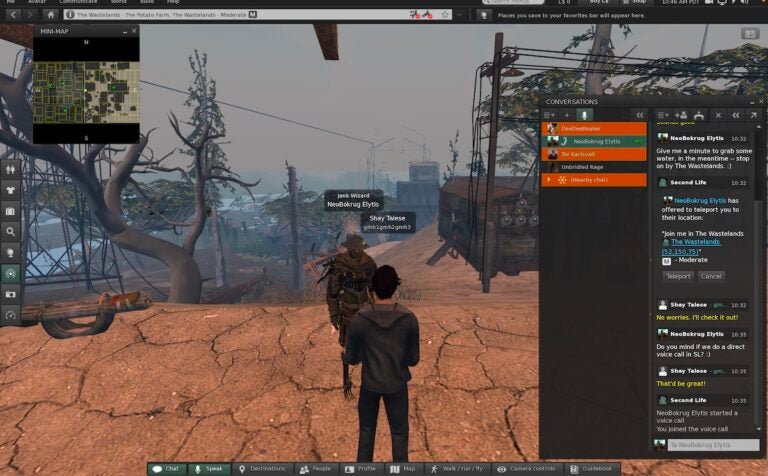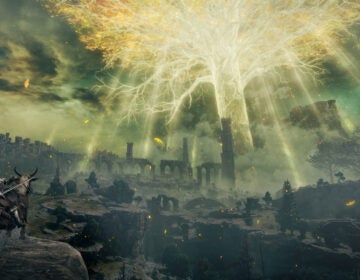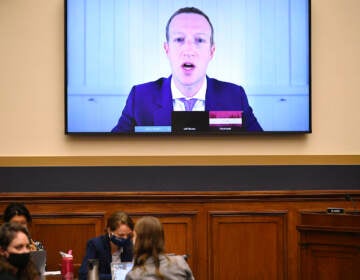Democracy in the metaverse: What can we learn from Second Life?
Early metaverse pioneers on lessons learned using a 3D virtual platform.
Listen 16:19
Second Life is a 3D virtual world where users can connect and engage with others. Reporter Grant Hill’s avatar is seen walking through a post-apocalyptic community.(Screenshot of Second Life)
This story is from The Pulse, a weekly health and science podcast.
Find it on Apple Podcasts, Spotify, or wherever you get your podcasts.
Tor Karsvalt is an unusual head of state for several reasons.
For one thing, Tor Karsvalt is not his real name. And yet it’s the name his constituents voted for.
For another, the “state” he leads is entirely contained within the metaverse.
“We adhere to the principles of a democratically run society in Second Life,” Karsvalt said.
Karsvalt, whose real name is David Ben (“But that’s more or less irrelevant in this world,” he said), is the elected head of Confederation of Democratic Simulators, or CDS, the oldest running democracy within one of the oldest running metaverse platforms.
Decades before Facebook’s name change to Meta, the pandemic-era “Web3” hypecycle, or the announcement of the Apple VisionPro, there was Second Life: a 3D open-world virtual platform released in 2003 which, unlike other video games at the time, had no clear objectives or goals.
Instead, the platform’s creators, Linden Lab, promised an immersive utopian vision of “a new society, a new world, created by you.” Second Life’s state-of-the-art creation tools would allow users to generate their own objects to populate the world – clothes, furniture, buildings – that could be bought and sold on a marketplace using in-world currency swapped for real-world U.S. dollars.
Partly inspired by Burning Man, the internal economy would fuel innovation and spontaneously spark novel organizations. Users could buy virtual land, a virtual house, and virtual clothes.
As the internet boomed, Second Life seemed to hit at the right time.
Early imaginings of the metaverse in science fiction envisioned users driven into virtual worlds by real-world collapse and decay. Second Life sought to lure users in rather than wait for the apocalypse. Over 20 years later, many are still placing bets that, however it all goes down, the mass migration into the metaverse is not a matter of if it will happen — but when?
As American skies turned a visceral toxic orange for the second time in three years due to wildfires supercharged by climate change, now seemed like a good time to check in with metaverse pioneers who asked a different question: if we’re all one day going to be crammed into the metaverse together, how do we live with each other?
The Rise of Confederation of Democratic Simulators
A year into Second Life’s existence, as CDS citizens explained to me, familiar patterns had emerged.
Because the owners of virtual land in Second Life got to set the virtual rules on the land they owned, benign dictatorships were the norm.
Everything from what you could wear or what you could create was often up to a single tiny tyrant mayor who could afford the investment, said Karsvalt.
“Enforcing covenants and things like that. So residents [were] feeling pretty abused,” Karsvalt said.
On the other hand, lax enforcement could lead a community of users to fall into disrepair, like having an absentee landlord.
“They never show up and they don’t answer emails and things like that,” Karsvalt said.
Subscribe to The Pulse
So, in 2004, a small group of users approached Linden Lab to create a new way to organize society in Second Life on a piece of virtual land that was up for grabs in a contest set up by the parent company.
The idea was simple: instead of one person owning title to the land and making the rules, this land would be owned collectively by those who lived there and treated virtual democracy complete with elected representatives, an executive, and a judicial system.
Each citizen would have different responsibilities. The ones who could afford to lease the land from Linden Lab would help keep the community in good standing. Others would help build or delete things on their land.
Most importantly, no citizen could act unilaterally. Decisions would be reached only with the consent of the governed through regular elections, every citizen would contribute to shaping the community in their own way, whether they could afford to pay rent or not.
Linden Lab obliged.
“And the Lindens gave us a section of that region to establish our town,” said Karsvalt. “You can still go there now.”
An early version of CDS was born – fueled by the same revolutionary verve that attracted users to Second Life in the first place.
But within a matter of months, the experiment, the young virtual democracy, started to fall apart.
“It’s one of these things that end up becoming sort of a national myth, almost type of a thing,” said Karsvalt.
The event is now referred to by citizens as The Quake.
“The details are kind of murky as far as I know,” said Karsvalt “But it involved complaints about IP rights.”.
A dispute between the founders started this community got ugly, and suddenly its critical infrastructure started to disappear. Whole neighborhoods were wiped off the platform.
“So one of our two main founders is actually not welcome anymore,” Karsvalt said. “It was sort of an uprising.
Eventually, citizens were able to wrest back control. But as a result of the “Quake,” CDS changed its governing structure so that voting rights were reserved for only those who owned property in the community.
“It’s sort of a reactionary thing right … back to the 18th century,” Karsvalt said citing the need to stay in good financial standing with Linden Lab. “But we do purposely have small parcels here, so it’s really cost very little to get a vote in our community.”
Most parcels cost about $25 a month.
Things are much calmer now for Karsvalt and his 72 fellow CDS citizens. Maybe a bit too calm.
No winners or losers
In general, interest has waned in Second Life as a fertile metaverse platform. And those who do use the platform regularly tend seek out more than simulated bureaucracy.
The number of active users on the platform peaked in 2007, when it spike up to one million during the same year the platform was included in the plot of an episode of the hit TV show The Office.
“Immediately after that show came out, like hundreds of thousands of people piled in the Second Life,” said Wagner James Au, a journalist who authored a book about the making of Second Life.
Au said the platform failed to build on its early success, partly because of its lofty, and purposefully aimless, mission statement.
Au got a front row seat to the platform’s rise after Linden Lab recruited him to embed within Second Life and report on what users were doing there.
“Almost like a small-town reporter,” said Au. “Very quickly, I saw this as a microcosm of humanity in a virtual world space and all their aspirations and conflicts.”
But Au was struck by how paradoxically limited the platform seemed without any real “game” component. For many, the idea of starting humanity over from scratch was more stultifying than liberating.
WHYY is your source for fact-based, in-depth journalism and information. As a nonprofit organization, we rely on financial support from readers like you. Please give today.







